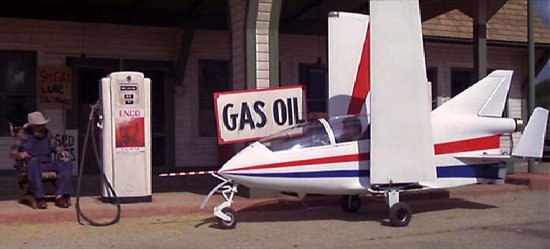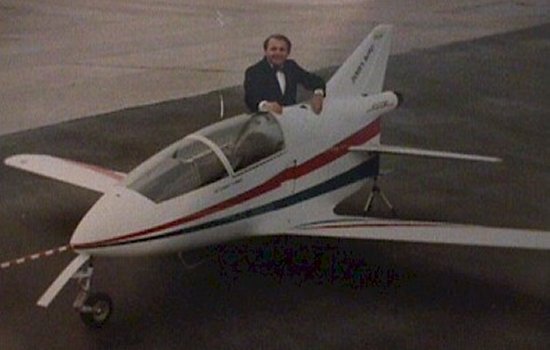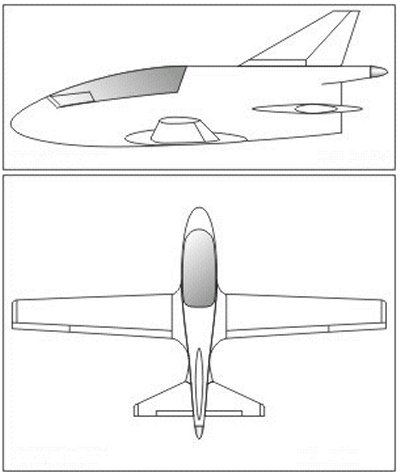|
||||||||||
|
|
||||||||||
|
||||||||||
|
|
||||||||||

The complex aerial acrobatics had used up his fuel supply, however, forcing Bond to make a landing on a road in the countryside. Folding the plane's wings back up, Bond rolls the craft into a nearby gas station where he nonchalantly requests, "Fill her up, please."

This opening sequence was a skillful mixture of the aircraft in flight and special effects. The credits of the film state that the aircraft is called the Acrostar that was built and piloted by John William "Corkey" Fornof. However, that is only part of the story behind this remarkable craft. The Acrostar is actually a kit plane designed by engineer Jim Bede and known as the Bede BD-5J. Some number of these kits were assembled to a modified design by Corkey Fornof along with fellow BD-5J enthusiast and stunt pilot Bob Bishop. These two pilots formed their own aerial acrobatic team called the Acrojets, and only their modified BD-5J models are actually referred to as the Acrostar (or Acro Star) Special. One of these Acrostars was filmed for "Octopussy" while being flown by both Fornof and another stunt pilot named Rick Holley.

Thanks in part to its exposure in the Bond film, the BD-5J is perhaps the most widely known of Jim Bede's creations. However, it represents only one member of the large family of homebuilt kit planes designed by this prolific engineer. Bede started as an aeronautical engineer at North American Aviation before he left to form his own company in 1961. The goal of Bede Aircraft Corporation was to develop low-cost and easy-to-fly planes for the homebuilt market. Bede's first design was the BD-1 completed in 1962 and followed by the BD-4 in 1969. These early designs saw moderate success in the aviation market while the experimental BD-2 also set a number of impressive range records.

These successes prompted Bede to push the performance envelope even farther with his next design. By 1971, he had finished the BD-5 that, like its earlier cousins, was powered by a piston engine. Bede also developed a jet derivative of the same airframe that was called the BD-5J. This jet version soon captured widespread attention thanks to its impressive displays at air shows. Aside from its appearance in "Octopussy," the BD-5J made a brief cameo in the later Bond film Die Another Day and has also been highlighted in several television advertisements. Examples of the BD-5J that have been featured in advertising campaigns are the Budweiser BudLight Jet, the Coors Light Silver Bullet, the Pepsi Microjet, and another featured in a Minolta Dynax commercial.
Despite its remarkable capabilities, the BD-5 series never quite lived up to its sales potential. The Bede company's early marketing campaign for the BD-5 was wildly successful and attracted as many as 4,000 kit orders by the end of 1971. The kit cost about $2,100 and required around 350 hours of labor to complete. When flown by a skilled pilot, the nimble craft was capable of impressive performance with a maximum speed of 200 mph (320 km/h) for the piston-powered model or 300 mph (480 km/h) aboard the jet. Control responsiveness was particularly sharp, although initial flight testing uncovered problems with the tail layout that necessitated a redesign.

Unfortunately, a much more difficult problem that plagued the design was finding an appropriate engine to power it. Bede went through several different engines for the piston version but was never able to find one of sufficient reliability and availability to meet the needs of his market. The jet-powered version fared little better since its Microturbo engine was quite rare and very expensive to purchase.
Besides the difficulty in locating a powerplant, customers also complained about how difficult the kit was to assemble. The design was quite sophisticated and proved too complicated, time-consuming, and costly for much of the homebuilt market to manufacture. Although over 3,000 BD-5 kits were made available, many were resold at a fraction of their original cost while others could not find customers at all. The poor sales and continued difficulties with engines ultimately forced Bede into bankruptcy by the end of the 1970s.

About 150 examples of the BD-5 were still flying by 2002, largely thanks to new companies that sprung up during the 1970s and 1980s to provide expertise in assembling and locating engines for the kits. The BD-5J featured in "Octopussy" still exists and remains in Corkey Fornof's collection but is no longer flying. With its engine now removed and James Bond proudly emblazened across its tail, the Acrostar is currently displayed at the Museum of Flying in Santa Monica, California. Other examples of the BD-5 series are also owned by museums including the National Air & Space Museum, the Oakland Western Aerospace Museum, the Planes of Fame Museum, Grand Canyon, and the Pima Air & Space Museum.
Several more of the unique aircraft are still flown by an aerobatic flight demonstration company called Freedom Jet that was founded by pilot Bob Bishop. While Bishop continues to amaze spectators at air shows, his fleet of Freedom Jets has also found valuable use in a number of military projects for both the US Air Force and US Navy. The small size, high speed, and manueverability of the microjets has made them well-suited to simulating low-altitude cruise missiles in several military and homeland security tests.

Juan Jiménez of San Juan, Puerto Rico, owns another airworthy example. This model has been modified with lightweight components to become the lightest example of the BD-5J, and perhaps the entire BD-5 series, ever built. With an empty weight of just 358 lb (162 kg), the aircraft is so light that the Guinness Book of World Records officially certified it as the world's smallest jet-powered plane in 2004. The tiny jet is just 12 ft (3.7 m) in length with a wingspan of 17 ft (5.7 m). Many more details about this amazing plane can be found at the site of Juan Jiménez and Rob de Bie's page documenting the history of several BD-5J kits.
Despite the sales difficulties the BD-5 originally suffered, Jim Bede was later able to reform his company and
continues to design new planes for the homebuilt market. In addition to his early designs that Bede continues to
improve with new technology, he is also currently working on new models called the BD-17 and BD-18.
- answer by Jeff Scott, 8 January 2006
Related Topics:
Read More Articles:


|
Aircraft | Design | Ask Us | Shop | Search |

|
|
| About Us | Contact Us | Copyright © 1997-2023 | |||
|
|
|||